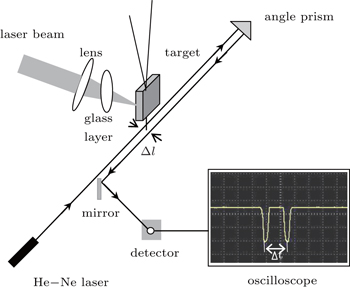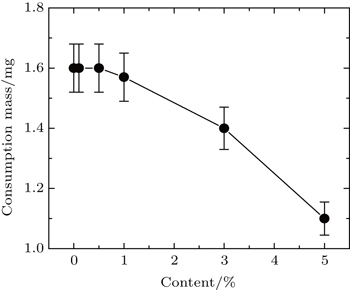† Corresponding author. E-mail:
Project supported by the National Natural Science Foundation of China (Grant No. 10905049) and the Fundamental Research Funds for the Central Universities, China (Grant Nos. 53200859165 and 2562010050).
The characteristics of droplets ejected from liquid glycerol doped with carbon are investigated in laser ablation propulsion. Results show that carbon content has an effect on both the coupling coefficient and the specific impulse. The doped-carbon moves the laser focal position from the glycerol interior to the surface. This results in a less consumed glycerol and a high specific impulse. An optimal propulsion can be realized by varying carbon content in glycerol.
In laser plasma propulsion, liquid propellants are considered as optimal materials because they significantly enhance the thrust compared with the solid target materials.[1–5] And many experiments have been performed to investigate the interaction of the laser pulses with liquids and liquid-containing materials.[6–9] For all liquid materials, however, a serious splashing behavior results in a very low specific impulse. This is essentially due to the fact that the splashing of the liquid causes laser energy to be consumed for droplet formation instead of high velocity plasma acceleration. In order to enhance the specific impulse, a small container or droplet, as well as doped-liquids is used. Shadowgraph images revealed that the splashing behavior could be controlled by the viscosity of liquid propellant.[6] Furthermore, in the experiments carried out in the present work, carbon-ink-doped water is used as the liquid propellant and 19 s of specific impulse is achieved.[7] Considering both the doping method and the liquid viscosity, the carbon-doped glycerol has been proposed recently to reduce the splashing and to enhance the specific impulse.[2,3] In these papers, only the shadowgraph images revealing the time evolution of the splashing were described. A few publications were involved in the study of the characteristics of droplets ejected from the carbon doped glycerol. In particular, there are a few reports on the measurement of droplet characteristics regarding the coupling coefficient, specific impulse, angular distribution and ablation pressure as well as the relationship between them.[10] These parameters can help us to clarify the effect of the doped-carbon on the propulsion.
In this present paper, the characteristics of the droplets ejected from the liquid glycerol doped with carbon ablation by nanosecond pulse laser are measured. Based on the laser focal position, laser energy, and plasma luminescence, the effects of doped-carbon on propulsion are discussed.
The container used in the experiments is an aluminum cuboid with dimensions of 3 mm×8 mm×5 mm. A cavity with a depth of 2.5-mm and a diameter of 1.5-mm within the cuboid is used as a container to hold the liquid glycerol. Laser pulses are directly focused by a lens (f = 200 mm, ϕ = 50 mm) into the cavity bottom. The pulse laser used has a wavelength of 532 nm, a duration of 10 ns, and a maximum energy of approximately 250 mJ. The target velocity is measured by a photo-electric device. The schematic of target velocity measurement is shown in Fig.
 | Fig. 1. Schematic diagram of the experimental setup for a He–Ne laser source to measure target velocity. |
A glass layer of 1 mm in thickness and 50 mm in diameter is placed 45 mm away from the target surface to serve as a receiving screen. From the distribution area of droplets on the receiving screen, the ejection angle can be estimated. A force sensor is placed gently on the back surface of the aluminum cuboid to record the ablation pressure. From the amplitude of the signal recorded by an oscilloscope, the pressure force can be calculated. The carbon content values in glycerol are 0.1, 0.5, 1, 3, and 5 wt%. To exactly control the liquid glycerol volume, a micro-liter syringe with a precision of 0.5 μL is used. Under this condition, a good repeatability is ensured. For measuring the consumption mass caused by the laser ablation, the glycerol is directly weighted before and after ablation by a balance with a precision of 0.01 mg.
Figure
 | Fig. 2. Variations of coupling coefficient and specific impulse with carbon content. The zero point corresponds to the pure glycerol. The incident laser energy is 14 mJ in this condition. |
As the laser focal position moves from the glycerol bottom to the surface, laser intensity varies correspondingly. From the definition of laser intensity it follows that under the same laser focal area, the laser intensity is determined by the laser energy. Thus, the coupling coefficient and specific impulse are related to the laser energy as shown in Fig.
 | Fig. 4. Plots of coupling coefficient and specific impulse versus laser energy, with 1% carbon content ablated. |
A direct distribution of the glycerol droplets is shown in Fig.
 | Fig. 5. Typical images of droplet distribution with carbon content values of 0% (a), 0.1% (b), 0.5% (c), 1% (d), 3% (e), 5% (f). |
The angle distribution deduced from the distribution area and corresponding ablation pressure are shown in Fig.
Moreover, when laser pulse is focused into the glycerol, a certain amount of an-ionized glycerol is ejected. In this process, a certain liquid layer can play a role of confinement. Under the confinement ablation, the coupling coefficient has been enhanced by tens of times.[11,14] As the focal position moves from the glycerol bottom to the surface, the confinement ablation becomes weaker. The ablation pressure decreases to approximate 0.1 N.
The plasma luminescence generated at different carbon content is also measured by a photodiode with a picosecond response time, and is recorded by an oscilloscope. The results given in Fig.
In this work, the characteristics of the droplets ejected from glycerol doped with carbon are investigated through ablation by a nanosecond laser. Because the carbon-doping changes the laser focal position and laser intensity, the coupling coefficient, specific impulse, distribution angle as well as the ablation pressure present a different behavior compared with those in pure glycerol. With carbon content increasing, the laser focal position is varied from the glycerol interior to surface, and less glycerol is consumed, which results in a high specific impulse. Base on this viewpoint, to reduce the splashing volume, high carbon content should be adopted. However, high carbon content corresponds to a low coupling coefficient. Through this process, an optimum coupling coefficient and specific impulse can be chosen by varying the carbon content.
| 1 | |
| 2 | |
| 3 | |
| 4 | |
| 5 | |
| 6 | |
| 7 | |
| 8 | |
| 9 | |
| 10 | |
| 11 | |
| 12 | |
| 13 | |
| 14 | |
| 15 | |
| 16 | |
| 17 |





